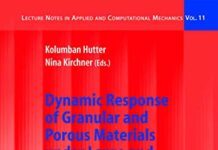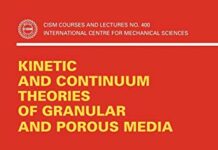
Ebook Info
- Published: 2016
- Number of pages: 653 pages
- Format: PDF
- File Size: 16.99 MB
- Authors: Kolumban Hutter
Description
In this book fluid mechanics and thermodynamics (F&T) are approached as interwoven, not disjoint fields. The book starts by analyzing the creeping motion around spheres at rest: Stokes flows, the Oseen correction and the Lagerstrom-Kaplun expansion theories are presented, as is the homotopy analysis. 3D creeping flows and rapid granular avalanches are treated in the context of the shallow flow approximation, and it is demonstrated that uniqueness and stability deliver a natural transition to turbulence modeling at the zero, first order closure level. The difference-quotient turbulence model (DQTM) closure scheme reveals the importance of the turbulent closure schemes’ non-locality effects. Thermodynamics is presented in the form of the first and second laws, and irreversibility is expressed in terms of an entropy balance. Explicit expressions for constitutive postulates are in conformity with the dissipation inequality. Gas dynamics offer a first application of combined F&T. The book is rounded out by a chapter on dimensional analysis, similitude, and physical experiments.
User’s Reviews
Editorial Reviews: From the Back Cover In this book fluid mechanics and thermodynamics (F&T) are approached as interwoven, not disjoint fields. The book starts by analyzing the creeping motion around spheres at rest: Stokes flows, the Oseen correction and the Lagerstrom-Kaplun expansion theories are presented, as is the homotopy analysis. 3D creeping flows and rapid granular avalanches are treated in the context of the shallow flow approximation, and it is demonstrated that uniqueness and stability deliver a natural transition to turbulence modeling at the zero, first order closure level. The difference-quotient turbulence model (DQTM) closure scheme reveals the importance of the turbulent closure schemes’ non-locality effects. Thermodynamics is presented in the form of the first and second laws, and irreversibility is expressed in terms of an entropy balance. Explicit expressions for constitutive postulates are in conformity with the dissipation inequality. Gas dynamics offer a first application of combined F&T. The book is rounded out by a chapter on dimensional analysis, similitude, and physical experiments.
Reviews from Amazon users which were colected at the time this book was published on the website:
⭐Not found.
⭐Not found.
⭐Not found.
⭐Not found.
Keywords
Free Download Fluid and Thermodynamics: Volume 2: Advanced Fluid Mechanics and Thermodynamic Fundamentals (Advances in Geophysical and Environmental Mechanics and Mathematics) in PDF format
Fluid and Thermodynamics: Volume 2: Advanced Fluid Mechanics and Thermodynamic Fundamentals (Advances in Geophysical and Environmental Mechanics and Mathematics) PDF Free Download
Download Fluid and Thermodynamics: Volume 2: Advanced Fluid Mechanics and Thermodynamic Fundamentals (Advances in Geophysical and Environmental Mechanics and Mathematics) 2016 PDF Free
Fluid and Thermodynamics: Volume 2: Advanced Fluid Mechanics and Thermodynamic Fundamentals (Advances in Geophysical and Environmental Mechanics and Mathematics) 2016 PDF Free Download
Download Fluid and Thermodynamics: Volume 2: Advanced Fluid Mechanics and Thermodynamic Fundamentals (Advances in Geophysical and Environmental Mechanics and Mathematics) PDF
Free Download Ebook Fluid and Thermodynamics: Volume 2: Advanced Fluid Mechanics and Thermodynamic Fundamentals (Advances in Geophysical and Environmental Mechanics and Mathematics)





